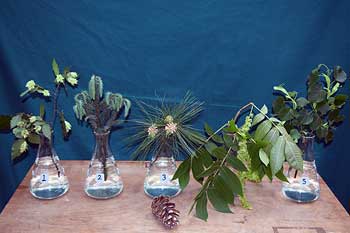Spring Pushes Forth at the Washington Park Arboretum

(May 16 – 30, 2016)
1) Ostrya carpinifolia Hop Hornbeam
- This small-to-medium-sized tree (40-50’) is native to southern Europe and southwestern Asia.
- The common name refers to the fruit which resembles the fruit of Humulus (Hops).
- Ostrya is from Greek, meaning “bone-like” in reference to the trees dense hard wood.
- Located north of East Foster Island Road, east of the Broadmoor entrance.
2) Picea mariana ‘Doumetii’ Doumet Black Spruce
- This selection of Picea mariana is a popular slow-growing shrub with blue green needles and a dense conical growth habit.
- Located along Arboretum Drive on the north end of the Magnolia Collection.
3) Pinus x schwerinii Schwerin’s Pine
- Schwerin’s Pine is an interspecies cross between Himalayan White Pine (Pinus wallichiana) and Weymouth Pine (Pinus strobus). It was found by Earl Schwerin in his park in Wilmersdorf (near Berlin, Germany) in 1905.
- Our fine specimen is located north of the Crabapple Meadow near the service road.
4) Pterocarya macroptera Large–Winged Wingnut
- Native to northern China, the Wingnut is a fast-growing, medium height tree to 50-70 feet tall and 40 feet wide.
- This tree boasts ornamental spikes of fruit with broad wings in long pendulous spikes.
- This tree can be seen in fruit east of Arboretum Drive and south of the Crabapple Meadow. Look for the long bright green chains before you reach the service road.
5) Tillia cordata ‘Bicentennial’ Bicentennial Littleleaf Linden
- This selection of the popular street tree is known for a dense and conical form.
- Its moderate size makes Tillia cordata useful in areas where space is limited.
- Littleleaf Linden is known for its sweetly-scented spring flowers. Tillia fruit are held below a stiff bract similar to that on a maple seed which acts like a “helicopter” as it falls.
- A fine specimen can be seen at the intersection of Arboretum Drive and East Foster Island Road.